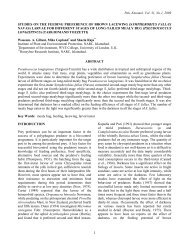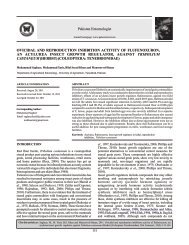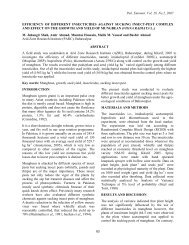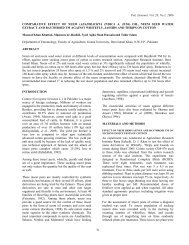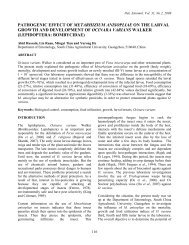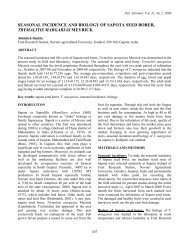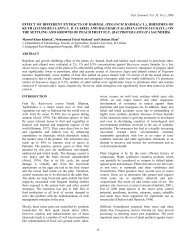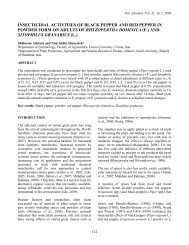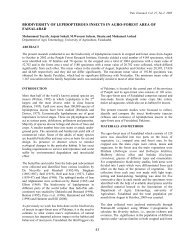efficacy of biocontrol agents combined with insecticide against the ...
efficacy of biocontrol agents combined with insecticide against the ...
efficacy of biocontrol agents combined with insecticide against the ...
You also want an ePaper? Increase the reach of your titles
YUMPU automatically turns print PDFs into web optimized ePapers that Google loves.
Pak. Entomol. Vol. 29, No.2, 2007<br />
EFFICACY OF BIOCONTROL AGENTS COMBINED WITH INSECTICIDE AGAINST THE<br />
LARGER GRAIN BORER PROSTEPHANUS TRUNCATES (HORN.) (BOSTRICHIDAE:<br />
COLEOPTERA)<br />
Abdul Rehman Dhuyo and B. J. Selman*<br />
Rice Research Institute, Dokri, Sindh, Pakistan<br />
*School <strong>of</strong> Biology, University <strong>of</strong> Newcastle upon Tyne, UK<br />
ABSTRACT<br />
The biological <strong>agents</strong>, <strong>the</strong> predator Teretrosoma negrescens (Lewis) and <strong>the</strong> entomogenous fungus Beauveria<br />
bassiana (Bol.) can successfully suppress population <strong>of</strong> <strong>the</strong> larger grain borer, Prostephanus truncates (Horn.)<br />
(Bostrichidae: Coleoptera). The <strong>insecticide</strong> pirimiphos-methyl produced 100 % mortality <strong>of</strong> adult P. truncates and<br />
96.81 % mortality <strong>of</strong> <strong>the</strong> predator T. nigrescens. P. truncates was more susceptible to <strong>the</strong> <strong>insecticide</strong> than was <strong>the</strong><br />
predator. A concentration <strong>of</strong> 1.611x10 6 spores / ml <strong>of</strong> B. bassiana killed 50 % <strong>of</strong> a mixed population <strong>of</strong> <strong>the</strong> larger<br />
grain borer populations. A dose 10 6 spore / ml <strong>of</strong> <strong>the</strong> fungus B. bassiana was used in <strong>the</strong>se experiments. The use <strong>of</strong><br />
<strong>the</strong> entomogenous fungus isolate No. 274 and release <strong>of</strong> <strong>the</strong> predator T. negrescens for <strong>the</strong> control <strong>of</strong> P. truncates<br />
would be beneficial wherever <strong>insecticide</strong>s are used too frequently.<br />
Key words: Beauveria bassiana, Prostephanus truncates, biopesticide, Insecticide, control, predator<br />
INTRODUCTION<br />
The use <strong>of</strong> biological control <strong>agents</strong> as biopesticides<br />
has wide scope in Integrated Pest Management<br />
(IPM). Their use has resulted in environmentally<br />
sound pest control methods <strong>with</strong> little danger <strong>of</strong> <strong>the</strong><br />
development <strong>of</strong> resistance, and no lethal effect on<br />
non-target organisms.<br />
Fumigants and residual <strong>insecticide</strong>s have been used to<br />
control stored grain pests. The use <strong>of</strong> chemical<br />
<strong>insecticide</strong>s has <strong>the</strong> more obvious approach <strong>of</strong><br />
hygiene and cleanliness (Adane et al., 1996). The use<br />
<strong>of</strong> chemical <strong>insecticide</strong>s <strong>against</strong> crop pests and stored<br />
product pests has resulted in environmental damage,<br />
lethal effects on beneficial organisms and also <strong>the</strong><br />
problem <strong>of</strong> chemical residues remaining in <strong>the</strong> food.<br />
Dick (1988) pointed out that alternative methods to<br />
chemical control were needed including <strong>the</strong> use <strong>of</strong><br />
biological control <strong>agents</strong>.<br />
Recent development in <strong>the</strong> microbial control <strong>of</strong> insect<br />
pests has indicated that <strong>the</strong> entomogenous fungi have<br />
great potential for <strong>the</strong> control <strong>of</strong> a variety <strong>of</strong> insect<br />
pests (Robert and Yendol, 1971; Ferron 1978, 1981;<br />
Burges, 1981). Currently 20 microbial pest control<br />
<strong>agents</strong> are registered <strong>with</strong> <strong>the</strong> Environmental<br />
Protection Agency (USA) (Starnes et al., 1993).<br />
Little comparable work relating to stored product<br />
pests has been done (Searle and Doberski, 1984).<br />
Khan and Selman (1984, 1987, 1988) examined <strong>the</strong><br />
effect <strong>of</strong> Nosema whitei alone or in combination <strong>with</strong><br />
<strong>insecticide</strong>s on Tribolium castaneum. Rodrigues and<br />
Pratissoli (1990) worked <strong>with</strong> Metarhizium<br />
anisopliae (Mots) and Beauveria brongniarti (Sacc)<br />
<strong>against</strong> <strong>the</strong> maize weevil.<br />
Recently <strong>the</strong>re has been interest in using B. bassiana<br />
<strong>against</strong> stored product pests. This is partly because it<br />
can be applied in <strong>the</strong> same way as chemical pesticides<br />
<strong>with</strong> similar quick acting results. The results show<br />
that B. bassiana has great potential for <strong>the</strong> control <strong>of</strong><br />
<strong>the</strong> larger grain borer. The studies showed that all<br />
stages <strong>of</strong> <strong>the</strong> predator T. nigrescens were more<br />
resistant to B. bassiana than <strong>the</strong> larger grain borer,<br />
P. truncates.<br />
Predators are used as <strong>biocontrol</strong> <strong>agents</strong> to reduce pest<br />
damage to tolerable levels over long periods. The<br />
results show that both <strong>the</strong> larvae and adults <strong>of</strong> <strong>the</strong><br />
predator T. nigrescens are effective predators <strong>of</strong> P.<br />
truncates. After successfully determining <strong>the</strong> biology<br />
and functional response to <strong>the</strong> predator T. nigrescens<br />
<strong>against</strong> its prey, <strong>the</strong> larger grain borer, it is necessary<br />
to compare <strong>the</strong> losses <strong>of</strong> maize grain caused by P.<br />
truncates treated <strong>with</strong> fungus and <strong>the</strong> predator, and to<br />
compare <strong>the</strong> numbers <strong>of</strong> progeny produced by both<br />
prey and predator.<br />
The contact chemical <strong>insecticide</strong> pirimiphos methyl<br />
has been widely used to control P. truncates in Africa<br />
(Peter et al., 1990; Dales and Golob, 1997). If T.<br />
57
Pak. Entomol. Vol. 29, No.2, 2007<br />
nigrescens is to be used as a <strong>biocontrol</strong> agent for P.<br />
truncatus, it is necessary to consider <strong>the</strong> pathogenic<br />
effects <strong>of</strong> both <strong>the</strong> fungus B. bassiana and <strong>the</strong><br />
chemical <strong>insecticide</strong> pirimiphos-methyl to <strong>the</strong><br />
predator T. nigrescens.<br />
The objectives <strong>of</strong> <strong>the</strong> present studies were to evaluate<br />
<strong>the</strong> <strong>efficacy</strong> <strong>of</strong> <strong>the</strong> biological control <strong>agents</strong> B.<br />
bassiana and T. nigrescens <strong>against</strong> P. truncates and<br />
also T. nigrescens when <strong>combined</strong> <strong>with</strong> <strong>the</strong><br />
<strong>insecticide</strong> pirimiphos-methyl.<br />
MATERIALS AND METHODS<br />
Adults <strong>of</strong> P. truncates and T. nigrescens were<br />
collected from rearing cultures at 30 °C and 70 %<br />
R.H. 5 - 10 day old beetles <strong>of</strong> both <strong>the</strong> prey and<br />
predator were used in <strong>the</strong> experiments. Fifty grams <strong>of</strong><br />
French maize ex pigeon feed grain were used for each<br />
treatment to feed P. truncates in 500 gram capacity<br />
jars. The maize grains were checked for previous<br />
damage before use in <strong>the</strong> experiments. In each<br />
treatment ei<strong>the</strong>r <strong>the</strong> fungus B. bassiana or <strong>the</strong><br />
<strong>insecticide</strong> pirimiphos-methyl was used <strong>against</strong> <strong>the</strong><br />
larger grain borer <strong>with</strong> or <strong>with</strong>out <strong>the</strong> predator T.<br />
nigrescens and <strong>the</strong> results compared to P. truncates<br />
alone or controlled solely using T. nigrescens. Details<br />
<strong>of</strong> <strong>the</strong> treatments are given in Table 1.<br />
Table 1. Treatments used for <strong>the</strong> control <strong>of</strong> <strong>the</strong> larger grain borer P. truncates<br />
Treatments (T ) Prey <strong>with</strong> predator treated <strong>with</strong> fungus or <strong>insecticide</strong><br />
Prey (50) Predator (10) Fungus Insecticide<br />
T1 P. truncates - - -<br />
T2 P. truncates T. nigrescens - -<br />
T3 P. truncates - B. bassiana -<br />
T4 P. truncates T. nigrescens B. bassiana -<br />
T5 P. truncates - - Pirimiphos-methyl<br />
T6 P. truncates T. nigrescens - Pirimiphos-methyl<br />
A conidial suspension <strong>of</strong> B. bassiana <strong>of</strong> a dose<br />
(1.611x10 6 , spore -1 ) was sprayed onto adults <strong>of</strong> P.<br />
truncates or T. nigrescens <strong>with</strong> a perfume sprayer.<br />
Pirimiphos-methyl was sprayed onto maize at a dose<br />
<strong>of</strong> 0.05 grams per 50 grams <strong>of</strong> maize grain (Golob,<br />
1988). The treated grain was shaken thoroughly to<br />
ensure that <strong>the</strong> <strong>insecticide</strong> was distributed evenly<br />
throughout <strong>the</strong> grain. There were six replicates for<br />
each treatment. The surviving populations <strong>of</strong> P.<br />
truncates and T. nigrescens were recorded 65 days<br />
after treatment. The grain loss was assessed by<br />
weighing <strong>the</strong> flour and maize debris. The losses were<br />
compared <strong>with</strong> biological <strong>agents</strong> or <strong>insecticide</strong><br />
(pirimiphos-methyl) and an untreated control.<br />
RESULTS AND DISCUSSION<br />
The populations <strong>of</strong> <strong>the</strong> larger grain borer<br />
Prostephanus truncates and its predator T.<br />
nigrescens are shown in Table 2. The total number <strong>of</strong><br />
P. truncates recorded from each treatment in <strong>the</strong><br />
progeny bioassay included <strong>the</strong> 50 parent beetles<br />
initially introduced and also <strong>the</strong> 10 T. nigrescens<br />
when <strong>the</strong>se predators were part <strong>of</strong> <strong>the</strong> treatment. In a<br />
comparison <strong>of</strong> <strong>the</strong> effects <strong>of</strong> <strong>the</strong> biological <strong>agents</strong> B.<br />
bassiana and T. nigrescens on populations <strong>of</strong> <strong>the</strong><br />
larger grain borer, <strong>the</strong> fungus B. bassiana allowed<br />
<strong>the</strong> production <strong>of</strong> more adults and larvae <strong>of</strong> P.<br />
truncates than did <strong>the</strong> predator T. nigrescens. The<br />
results showed that <strong>the</strong> predator was a more efficient<br />
agent to control populations <strong>of</strong> P. truncates than <strong>the</strong><br />
fungus B. bassiana (Table 2).<br />
The for weight loss <strong>of</strong> maize grains in different<br />
treatments are presented in Fig. 1. There was a highly<br />
statistical significant difference (P
Pak. Entomol. Vol. 29, No.2, 2007<br />
<strong>insecticide</strong>, predator, fungus and <strong>the</strong> control,<br />
respectively (Table 4). The surviving populations <strong>of</strong><br />
<strong>the</strong> progeny <strong>of</strong> <strong>the</strong> predator T. nigrescens are shown<br />
in <strong>the</strong> Fig 2. Very high numbers <strong>of</strong> adult T.<br />
nigrescens were counted in <strong>the</strong> fungus treatments and<br />
low numbers in <strong>the</strong> <strong>insecticide</strong> treatments. There was<br />
a highly significant difference between <strong>the</strong> fungus,<br />
<strong>insecticide</strong> and control treatments (Table 5).<br />
Teretrosoma nigrescens was much more susceptible<br />
to <strong>the</strong> <strong>insecticide</strong> pirimiphos-methyl than to <strong>the</strong><br />
fungus B. bassiana. Peter et al. (1990) observed T.<br />
nigrescens to be susceptible to <strong>insecticide</strong>s. However,<br />
<strong>the</strong> predator was more resistant to pirimiphos-methyl<br />
than was <strong>the</strong> larger grain borer. Pirimiphos-methl is a<br />
compound which has been specifically recommended<br />
for <strong>the</strong> control <strong>of</strong> P. truncates (Dales and Golob,<br />
1997).<br />
All treatments reduced <strong>the</strong> losses <strong>of</strong> grain and <strong>the</strong><br />
number <strong>of</strong> progeny <strong>of</strong> <strong>the</strong> larger grain borer, P.<br />
truncates. P. truncates was significantly more<br />
susceptible to <strong>the</strong> <strong>insecticide</strong> pirimiphos-methyl than<br />
was <strong>the</strong> predator, T. nigrescens. The adults and<br />
larvae <strong>of</strong> P. truncates survived better <strong>with</strong> <strong>the</strong> fungus<br />
treatment than <strong>with</strong> <strong>the</strong> predator. A 100 % mortality<br />
<strong>of</strong> P. truncates was recorded in <strong>the</strong> <strong>insecticide</strong> only<br />
application. There was no statistical difference in <strong>the</strong><br />
loss <strong>of</strong> maize grain caused by P. truncates between<br />
<strong>the</strong> predator only and <strong>the</strong> fungus only treatments.<br />
However, <strong>the</strong> predator was more resistant to <strong>the</strong><br />
fungus B. bassiana isolate 274 than was P.<br />
truncates.<br />
The present investigations conclude that <strong>the</strong><br />
biological <strong>agents</strong> T. nigrescens and B. bassiana can<br />
successfully suppress populations <strong>of</strong> <strong>the</strong> larger grain<br />
borer. The use <strong>of</strong> <strong>the</strong> entomogenous fungus B.<br />
bassiana isolate 274 and <strong>the</strong> release <strong>of</strong> <strong>the</strong> predator<br />
T. nigrescens for <strong>the</strong> control <strong>of</strong> P. truncates would<br />
be beneficial wherever <strong>insecticide</strong>s are now used too<br />
frequently.<br />
Table 2. Survival and reproductive success <strong>of</strong> P. truncates and T. nigrescens in 50g maize grains when<br />
inoculated <strong>with</strong> conidiospores <strong>of</strong> <strong>the</strong> fungus B. bassiana isolate No. 274 and when treated <strong>with</strong> <strong>the</strong><br />
<strong>insecticide</strong> pirimiphos-methyl (values are means <strong>of</strong> 6 replicates)<br />
Treatment<br />
Population <strong>of</strong> culture<br />
Prostephanus truncates<br />
Teretrosoma nigrescens<br />
Adults<br />
percentage<br />
Larvae No.<br />
(mean±SE)<br />
Pupae No.<br />
(mean±SE)<br />
Adults<br />
percentage<br />
Larvae No.<br />
(mean±SE)<br />
Pupae No.<br />
(mean±SE)<br />
Control<br />
100.00 100.00a 10.00 0 0 0<br />
P. truncates alone ± 4.398a ± 5.338a ± 0.671<br />
With predator alone 30.13<br />
± 3.587b<br />
5.66b<br />
± 1.62b<br />
0 100.00<br />
± 0.840<br />
4.83<br />
± 0.477<br />
2.00<br />
± 0.43<br />
With<br />
36.60 c 39.26c 0 0 0 0<br />
B. bassiana alone ± 1.155 ± 2.045c<br />
B. bassiana + Predator 26.62<br />
± 1.500d<br />
2.93<br />
± 0.764b<br />
0 64.90<br />
± 0.477<br />
2.67<br />
± 0.477<br />
1.15<br />
± 0.21<br />
Insecticide 0 0 0 0 0 0<br />
Insecticide<br />
+ Predator<br />
0 0 0 3.19<br />
± 0.437<br />
Values <strong>of</strong> same letter in column are not significantly different.<br />
0 0<br />
59
Pak. Entomol. Vol. 29, No.2, 2007<br />
Fig. 1. Comparison <strong>of</strong> percentage weight losses caused by P. truncates to grain after different treatments<br />
using <strong>biocontrol</strong> <strong>agents</strong> and an <strong>insecticide</strong> (mean <strong>of</strong> six replications <strong>with</strong> 95 % confidence limits). Values<br />
followed by same letter are not significantly different (P
Pak. Entomol. Vol. 29, No.2, 2007<br />
Table 5. Analysis <strong>of</strong> variance for <strong>the</strong> progeny <strong>of</strong> <strong>the</strong> predator T. nigrescens (Lewis)<br />
Sources DF SS MS F values P values<br />
Treatments (control, fungus and <strong>insecticide</strong>s) 2 707.44 353.72 206.72
62<br />
Pak. Entomol. Vol. 29, No.2, 2007



